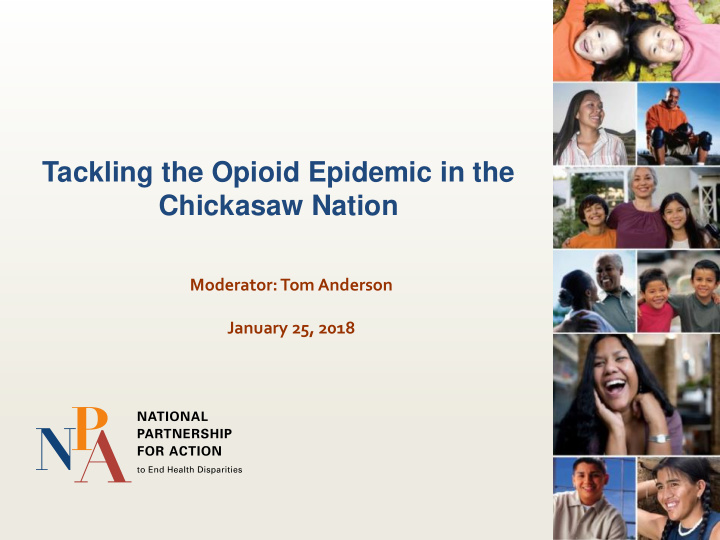



Tackling the Opioid Epidemic in the Chickasaw Nation Moderator: Tom Anderson January 25, 2018
Define Your Direction: Tackling the Opioid Epidemic in the Chickasaw Nation Miranda Willis Public Health Accreditation Coordinator Chickasaw Nation Division of Research and Population Health
Outline • Chickasaw Nation Overview • The Opioid Epidemic • Define Your Direction • Naloxone: Addressing the Opioid Overdose Deaths • Lockboxes and Drop Boxes: Limiting Community Access • Media Campaign: Raising Awareness and Promoting Prevention • Prosocial Activities: Building Community Capacity • Outcomes • Lessons Learned
American Indians in Oklahoma Indian Removal Act 1830
American Indians in Oklahoma Territorial Jurisdictions
The Chickasaw Nation
The Chickasaw Nation • 13 counties located in south-central Oklahoma • Non-reservation based • Population: 357,351 • American Indians: 52,288 Source: U.S. Census Bureau, 2012-2016 American Community Survey 5-Year Estimates
The Epidemic • In 2014, Oklahoma had the 10th highest drug overdose death rate in the nation 1 • From 2007 to 2015, 5,946 Oklahomans died from unintentional poisoning deaths 2 • Three out of every four unintentional poisoning deaths involve at least one prescription drug 3 Sources: 1. Oklahoma State Department of Health (OSDH). (2016). Reducing Prescription Drug Abuse in Oklahoma: A Review of Progress and Updated State Plan. 2. Oklahoma State Department of Health (OSDH). Center for Health Statistics, Health Care Information, Vital Statistics 2007 to 2015. (OK2SHARE). 3. Oklahoma State Department of Health: Injury Prevention Service. (2015, April). Unintentional Poisonings.
Source: Oklahoma State Department of Health, Injury Prevention Service, Fatal Unintentional Poisoning Surveillance System
Rx Misuse Among Youth • Percent of American Indian Students in Chickasaw Nation Reporting Rx Misuse in the Past 30 Days in 2012: • 6th Grade: 3.3 Percent • 8th Grade: 9.5 Percent • 10th Grade: 6.9 Percent • 12th Grade: 13.3 Percent Source: Oklahoma Needs Prevention Assessment. 2012. American Indian Students: Chickasaw Nation Boundaries.
Risk Factors • Percent of American Indian Students in Chickasaw Nation Reporting Risk for Substance Abuse in All Grades in 2012: • Low Neighborhood Attachment: 46.4 Percent • Early Initiation of Drug Use: 37.7 Percent • Friends Drug Use: 40.4 Percent • High Risk: 50.7 Percent Source: Oklahoma Needs Prevention Assessment. 2012. American Indian Students: Chickasaw Nation Boundaries.
Protective Factors • Percent of American Indian Students in Chickasaw Nation Reporting Protective Factors for Substance Abuse in All Grades in 2012: • Community-Opportunities for Prosocial Involvement: 55.8 Percent • Family-Opportunities for Prosocial Involvement: 55.8 Percent • School-Opportunities for Prosocial Involvement: 48.8 Percent • Peer Prosocial Involvement: 55.9 Percent • High Protection: 48.9 Percent Source: Oklahoma Needs Prevention Assessment. 2012. American Indian Students: Chickasaw Nation Boundaries.
Tackling the Opioid Epidemic • Strategic Prevention Framework-Tribal Incentive Grant (SPF-TIG) was awarded to the Southern Plains Tribal Health Board (SPTHB) • SPTHB collaborated with four tribal partners to combat substance abuse in Indian Country: • Absentee Shawnee Tribe • Cheyenne and Arapaho Tribes • The Chickasaw Nation • Comanche Nation
Strategic Prevention Framework • Strategic Prevention Framework: 1. Assessment 2. Capacity Building 3. Planning 4. Implementation 5. Evaluation • Goal: To reduce underage drinking and prescription drug misuse/abuse in our communities.
Define Your Direction • Underage Drinking and Prescription Drug Abuse Prevention Program that uses a multi-pronged approach to reduce underage drinking, prescription drug abuse and related deaths.
Naloxone • Equip Chickasaw Nation Lighthorse Police with the opioid antagonist medication, Naloxone and provide administration training • Collaborations • Chickasaw Nation Lighthorse • Chickasaw Nation Pharmacy
Safe Storage and Disposal • Educates community members on safe methods to store prescription medications and the proper disposal protocols
Define Your Direction • Media Campaign • Website • Print • Video • Social Media • Youth and Community Driven
Define Your Direction: Social Media Website: Defineyourdirection.com Facebook: Define Your Direction Twitter: @_YourDirection Instagram: Define Your Direction YouTube: Define Your Direction
Prosocial Activities
Define Your Direction: Prosocial Activities Allen Zombie Chase
Define Your Direction: Prosocial Activities Dickson Homecoming Allen Homecoming
Define Your Direction: Prosocial Activities
Define Your Direction: Prosocial Activities
Define Your Direction: Prosocial Activities
Define Your Direction: Prosocial Activities
Program Outcomes • All Chickasaw Nation Lighthorse officers equipped with Naloxone. • Within the first six months of implementation we had our first save using Naloxone. • More than 400 medication lockboxes have been distributed to our elders. • 4,100 followers across all Define Your Direction social media platforms.
Program Outcomes • Reduction in 30 Day Rx Drug Misuse in 6th, 8th, 10th, 12th Grades: • 6th: 12 Percent • 8th: 45 Percent • 10th: 16 Percent • 12th: 40 Percent Source: Oklahoma Needs Prevention Assessment. 2016. American Indian Students: Chickasaw Nation Boundaries.
Program Outcomes • Reduction in Risk Factors in 6th, 8th, 10th, 12th Grades: • Low Neighborhood Attachment- 13Percent • Early Initiation of Drug Use- 19 Percent • Friends Drug Use- 21 Percent • High Risk- 14 Percent (43.6) Source: Oklahoma Needs Prevention Assessment. 2016. American Indian Students: Chickasaw Nation Boundaries.
Program Outcomes • Increase in Protective Factors in 6th, 8th, 10th, 12th Grades: • Community-Opportunities for Prosocial Involvement + 3 Percent • Family-Opportunities for Prosocial Involvement + 7 Percent • School-Opportunities for Prosocial Involvement: + 24 Percent • Peer Prosocial Involvement + 4 Percent • High Protection + 17 Percent (57.1) Source: Oklahoma Needs Prevention Assessment. 2016. American Indian Students: Chickasaw Nation Boundaries.
Lessons Learned • All tribes and tribal communities are different. • Listen and learn from your community. • Don’t be afraid to be innovative or collaborative. • Learn and grow from failures. • Change doesn’t happen overnight. • Celebrate the successes (no matter how small).
Thank You! Miranda Willis Miranda.Willis@chickasaw.net
Questions and Answer Session Please complete an assessment of the webinar by clicking the link below: https://app.smartsheet.com/b/form/583dde247b3e 43348bc8aa255e46ebd2 Thank you for participating! The webinar recording will be posted at: http://aian.npa-rhec.org/home 3 5
Recommend
More recommend